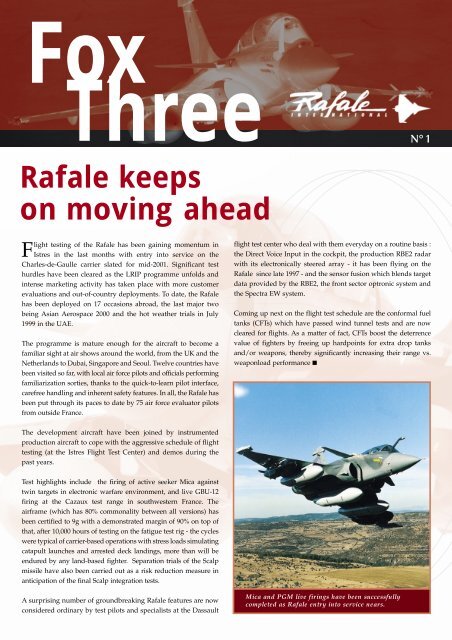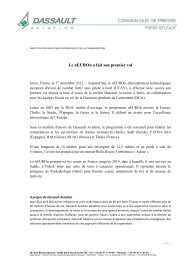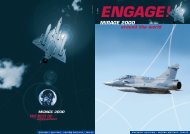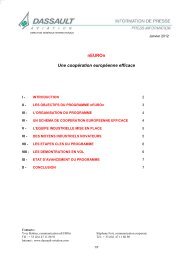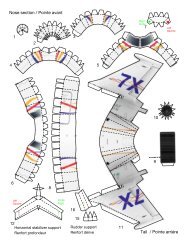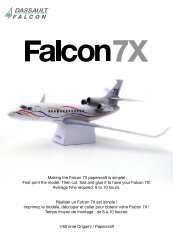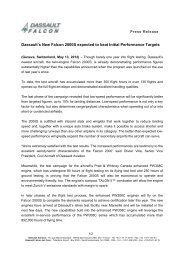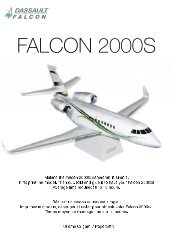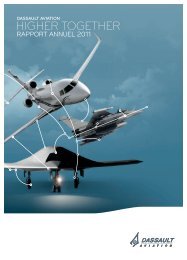Fox Three n°1.pdf - Dassault Aviation
Fox Three n°1.pdf - Dassault Aviation
Fox Three n°1.pdf - Dassault Aviation
You also want an ePaper? Increase the reach of your titles
YUMPU automatically turns print PDFs into web optimized ePapers that Google loves.
<strong>Fox</strong><br />
<strong>Three</strong><br />
Rafale keeps<br />
on moving ahead<br />
Flight testing of the Rafale has been gaining momentum in<br />
Istres in the last months with entry into service on the<br />
Charles-de-Gaulle carrier slated for mid-2001. Significant test<br />
hurdles have been cleared as the LRIP programme unfolds and<br />
intense marketing activity has taken place with more customer<br />
evaluations and out-of-country deployments. To date, the Rafale<br />
has been deployed on 17 occasions abroad, the last major two<br />
being Asian Aerospace 2000 and the hot weather trials in July<br />
1999 in the UAE.<br />
The programme is mature enough for the aircraft to become a<br />
familiar sight at air shows around the world, from the UK and the<br />
Netherlands to Dubai, Singapore and Seoul. Twelve countries have<br />
been visited so far, with local air force pilots and officials performing<br />
familiarization sorties, thanks to the quick-to-learn pilot interface,<br />
carefree handling and inherent safety features. In all, the Rafale has<br />
been put through its paces to date by 75 air force evaluator pilots<br />
from outside France.<br />
The development aircraft have been joined by instrumented<br />
production aircraft to cope with the aggressive schedule of flight<br />
testing (at the Istres Flight Test Center) and demos during the<br />
past years.<br />
Test highlights include the firing of active seeker Mica against<br />
twin targets in electronic warfare environment, and live GBU-12<br />
firing at the Cazaux test range in southwestern France. The<br />
airframe (which has 80% commonality between all versions) has<br />
been certified to 9g with a demonstrated margin of 90% on top of<br />
that, after 10,000 hours of testing on the fatigue test rig - the cycles<br />
were typical of carrier-based operations with stress loads simulating<br />
catapult launches and arrested deck landings, more than will be<br />
endured by any land-based fighter. Separation trials of the Scalp<br />
missile have also been carried out as a risk reduction measure in<br />
anticipation of the final Scalp integration tests.<br />
A surprising number of groundbreaking Rafale features are now<br />
considered ordinary by test pilots and specialists at the <strong>Dassault</strong><br />
N° 1<br />
flight test center who deal with them everyday on a routine basis :<br />
the Direct Voice Input in the cockpit, the production RBE2 radar<br />
with its electronically steered array - it has been flying on the<br />
Rafale since late 1997 - and the sensor fusion which blends target<br />
data provided by the RBE2, the front sector optronic system and<br />
the Spectra EW system.<br />
Coming up next on the flight test schedule are the conformal fuel<br />
tanks (CFTs) which have passed wind tunnel tests and are now<br />
cleared for flights. As a matter of fact, CFTs boost the deterrence<br />
value of fighters by freeing up hardpoints for extra drop tanks<br />
and/or weapons, thereby significantly increasing their range vs.<br />
weaponload performance ■<br />
Mica and PGM live firings have been successfully<br />
completed as Rafale entry into service nears.
The Spectra: a<br />
digital revolution<br />
Modern air warfare places a severe<br />
requirement on aircraft selfdefence<br />
capabilities, and only the most<br />
modern fighters will survive any major<br />
conflict. <strong>Dassault</strong> <strong>Aviation</strong> Mirage 2000-5<br />
and Rafale combat aircraft are equipped<br />
with highly-automated systems which<br />
provide an unprecedented level of<br />
protection against threats likely to appear<br />
in the future.<br />
The Spectra - Self-Protection Equipment<br />
Countering Threats of Rafale Aircraft -<br />
state-of-the-art self-defence system<br />
mounted on the Rafale is a complete and<br />
totally integrated electronic warfare suite<br />
designed and produced jointly by Thales<br />
Rafale M:<br />
First two accepted into service.<br />
In a ceremony held in December 2000 at Landivisiau Naval Air Station, the<br />
French Navy has accepted into service its first two Rafale M combat aircraft.<br />
This crucial event marks the beginning of an extensive fleet renewal programme<br />
encompassing the successive replacement of F-8E Crusader fighters, Etendard<br />
IVPM reconnaissance aircraft and Super Etendard strike fighters. A total of six<br />
pilots, including two French Air Force exchange officers, are currently involved<br />
in a Navy operational evaluation and tactics elaboration campaign which will<br />
culminate in complex air-defence exercises with multi-target multi-threat<br />
engagements.<br />
From January 2001 onwards, Rafale fighters will be delivered at the rate of<br />
one every two months, and the first front-line Squadron, Flottille 12F, will be<br />
officially reborn at Landivisiau in June. By the beginning of 2002, this unit<br />
will have taken delivery of ten Rafales out of 60 planned by the French Navy,<br />
bringing it to full operational status.<br />
and Matra Bae Dynamics. The system,<br />
which offers a dramatic increase in<br />
survivability against modern and<br />
emerging threats, is entirely mounted<br />
internally in an effort to keep weapon<br />
stations free, a big improvement over<br />
older designs such as Jaguars, Mirage F1s<br />
and Super Etendards which all needed<br />
external jammers and chaff/<br />
flare dispensers. It ensures efficient<br />
electromagnetic detection, laser warning,<br />
IR detection for missile warning, jamming<br />
and chaff/flare dispensing, even in the<br />
most demanding multi-threats environment.<br />
Spectra is divided into different<br />
modules and sensors strategically<br />
positioned throughout the airframe to<br />
provide all-round coverage. The latest<br />
advances in micro-electronic technology<br />
have led to a new system which is<br />
much lighter, more compact and less<br />
demanding than its ancestors in terms of<br />
electrical and cooling powers. Thanks to<br />
its advanced digital technology, Spectra<br />
provides passive long-range detection,<br />
identification and localisation of threats,<br />
and allows the pilot or system to react<br />
immediately with the best defensive
The Spectra System and its various components, on board the Rafale.<br />
measures: jamming, decoys, evasive<br />
manoeuvres and/or any combination of<br />
these actions. Moreover, SPECTRA<br />
features accurate Direction-finding and<br />
reduced time for signal identification.<br />
Additionally, very high processing<br />
power gives excellent detection and<br />
jamming performance, optimising the<br />
response to match the threat: incoming<br />
electromagnetic signals are analysed,<br />
and the bearing and location of<br />
the emitters are determined with great<br />
precision.<br />
The proliferation of new generation<br />
weapons such as man-portable<br />
surface-to-air missiles has raised concern<br />
among key decision makers. Both laser<br />
and IR missile warning systems have been<br />
mounted on the fighter. They provide<br />
360 degree coverage and ensure<br />
detection/warning of incoming threats.<br />
The IR missile warner ensures high<br />
probability of detection and low false<br />
alarm rate, even against totally passive<br />
IR-guided weapons. Four upward-firing<br />
launcher modules for various types of<br />
SPECTRA<br />
decoys - are built into the airframe, and<br />
the Rafale is equipped with internal<br />
chaff dispensers. The exact location and<br />
types of systems detected by Spectra can<br />
be recorded for later analysis, giving<br />
Rafale operators a substantial built-in<br />
SIGINT/ELINT capability while<br />
completing specialised dedicated<br />
intelligence platforms.<br />
But Spectra is much more than a<br />
traditional self-defence system as it is<br />
closely integrated with the primary<br />
sensors also supplied by Thales, the<br />
RBE2 multimode electronic scanning<br />
radar and the FSO passive front sector<br />
optronics system. As such, it considerably<br />
improves pilot situational awareness:<br />
all data obtained thanks to the various<br />
means are fused into a single tactical<br />
picture, offering the pilot a clear image of<br />
the evolving tactical situation. Spectra<br />
identifies the type of air-defence weapon,<br />
that has been detected; it takes the<br />
local terrain configuration into account<br />
and displays the lethality zones on<br />
a colour tactical screen, enabling the<br />
aircrew to avoid dangerous areas. This<br />
smart data fusion significantly increases<br />
mission success rates through enhanced<br />
crew awareness and improved aircraft<br />
survivability.<br />
The first Spectra flight onboard a Rafale<br />
took place in September 1996, after M02<br />
prototype had been retrofitted. Since then,<br />
the system has been thoroughly tested in<br />
very complex electronic warfare scenarios<br />
and environments. For instance, Rafale<br />
M02 was pitted against a wide variety<br />
of the latest IR-defence systems during<br />
the NATO Mace X trial organised in<br />
August 2000 in Southwest France, and its<br />
self-defence suite performed flawlessly.<br />
It is now in full production, and is already<br />
entering operational service onboard<br />
French Navy Rafale. Spectra, a particularly<br />
cost effective system, has been designed<br />
with growth in mind to keep the Rafale<br />
abreast of emerging threats ■
Rafale demonstrates<br />
Precision-Guided Munitions<br />
capabilities<br />
GBU-12s - included here in a swing-role configuration -<br />
provide precision strike capability with minimal collateral damages.<br />
<strong>Dassault</strong> <strong>Aviation</strong> has completed a<br />
series of test flights on the Rafale,<br />
dedicated to GBU-12s’ certification.<br />
The first LGB firings were carried out<br />
with the Rafale B01 development aircraft<br />
on the Cazaux test range in south western<br />
France and involved several swing role<br />
configurations, with Mica BVR missiles<br />
and 2000 l (530 USG) fuel tanks.<br />
The GBU-12 is a 500 lb Paveway<br />
2 laser-guided bomb which is fast<br />
becoming one of the most widely used<br />
weapons in precision strike operations,<br />
because of its pinpoint accuracy,<br />
low cost and widespread availability.<br />
Compared to heavier conventional bombs,<br />
it has the advantage of reduced collateral<br />
damage while retaining the same lethality<br />
against point targets due to its precision<br />
guidance.<br />
This development effort comes in the wake<br />
of the French Air Force engagements in<br />
joint operations over Bosnia and Kosovo<br />
stressing the political implications of<br />
precision strike capability. A fast track<br />
GBU-12 upgrade had to be fielded on Air<br />
Force Mirage F1CTs and Navy Super<br />
Etendards and the Rafale development<br />
agenda was also reshuffled according to<br />
lessons learned in combat by including<br />
the PGM capability into the definition<br />
of the first air force batch. One of the<br />
GIE - Rafale International - 78 quai Marcel <strong>Dassault</strong> - 92210 St Cloud - France<br />
configurations cleared during the recent<br />
separation trials featured 4 mid-wing<br />
mounted GBU-12s together with 4 AAMs<br />
(2 Mica and 2 Magic 2 - the wing-tip<br />
Magic are to be replaced by IR-guided<br />
Mica on the production aircraft) and three<br />
2000 l tanks. Combat radius is quoted<br />
at 800 nm unrefuelled, with up to 4<br />
ground targets assigned and a solid<br />
self-escort capability resting on the BVR<br />
Mica. Thanks to its carrying capability,<br />
stealth performance and multisensor<br />
fusion, Rafale brings an unprecedent<br />
level of tasking flexibility and of lethality.<br />
Risk reduction work had been performed<br />
prior to the test flights, with simulation<br />
runs using computational fluid dynamics<br />
software and with in-house GBU-12<br />
experience on other aircraft types.<br />
The PGM capability programme has been<br />
pushed on hard with guided GBU-12<br />
releases performed in late 2000 at Cazaux<br />
using a forward air controller. Selfdesignation<br />
of laser guided weapons is to<br />
be performed with the Thomson-CSF<br />
Damocles LDP now in development and<br />
available for test flights from 2002, well in<br />
time for export deliveries slated for 2004 ■


